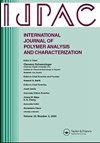Properties of hydrated poly(2-methoxyethyl acrylate) observed by 13C-nuclear magnetic resonance spectroscopy
IF 1.6
4区 工程技术
Q4 POLYMER SCIENCE
International Journal of Polymer Analysis and Characterization
Pub Date : 2023-01-01
DOI:10.1080/1023666X.2023.2248709
引用次数: 0
Abstract
It is well-known that poly(2-methoxyethyl acrylate) (PMEA) exhibits excellent blood compatibility and various investigations have examined the underlying mechanism of this compatibility in terms of the water structure in PMEA and/or inherent PMEA properties. However, information regarding the dynamic properties of the PMEA remains limited. This study was performed to clarify the effect of water molecules on the structure and dynamic properties of hydrated PMEA by comparing dry PMEA using temperature-variable 13C nuclear magnetic resonance spectroscopy (13C-NMR) with a solution probe at 15 –45 °C. Hydration changed the chemical shift values of the four carbons in the PMEA side chain (−COOCH2 CH2OCH3). Investigations of spin-lattice relaxation times and resonance peak widths showed that hydration increased PMEA mobility and the side chain mobility markedly changed at approximately 30 °C, especially in dry PMEA.
13c核磁共振波谱法观察水合聚(2-甲氧基乙基丙烯酸酯)的性质
众所周知,聚(2-甲氧基乙基丙烯酸酯)(PMEA)具有优异的血液相容性,各种研究已经从PMEA的水结构和/或PMEA固有特性方面研究了这种相容性的潜在机制。然而,关于PMEA动态特性的信息仍然有限。本研究通过在15 -45°C温度下使用变温13C核磁共振波谱(13C- nmr)将干燥PMEA与溶液探针进行比较,以阐明水分子对水合PMEA结构和动力学性能的影响。水合作用改变了PMEA侧链(−COOCH2 CH2OCH3)上4个碳的化学位移值。对自旋-晶格弛豫时间和共振峰宽度的研究表明,水化提高了PMEA的迁移率,并且在大约30°C时,侧链迁移率显著改变,特别是在干燥的PMEA中。
本文章由计算机程序翻译,如有差异,请以英文原文为准。
求助全文
约1分钟内获得全文
求助全文
来源期刊
CiteScore
3.50
自引率
5.30%
发文量
37
审稿时长
1.6 months
期刊介绍:
The scope of the journal is to publish original contributions and reviews on studies, methodologies, instrumentation, and applications involving the analysis and characterization of polymers and polymeric-based materials, including synthetic polymers, blends, composites, fibers, coatings, supramolecular structures, polysaccharides, and biopolymers. The Journal will accept papers and review articles on the following topics and research areas involving fundamental and applied studies of polymer analysis and characterization:
Characterization and analysis of new and existing polymers and polymeric-based materials.
Design and evaluation of analytical instrumentation and physical testing equipment.
Determination of molecular weight, size, conformation, branching, cross-linking, chemical structure, and sequence distribution.
Using separation, spectroscopic, and scattering techniques.
Surface characterization of polymeric materials.
Measurement of solution and bulk properties and behavior of polymers.
Studies involving structure-property-processing relationships, and polymer aging.
Analysis of oligomeric materials.
Analysis of polymer additives and decomposition products.

 求助内容:
求助内容: 应助结果提醒方式:
应助结果提醒方式:


